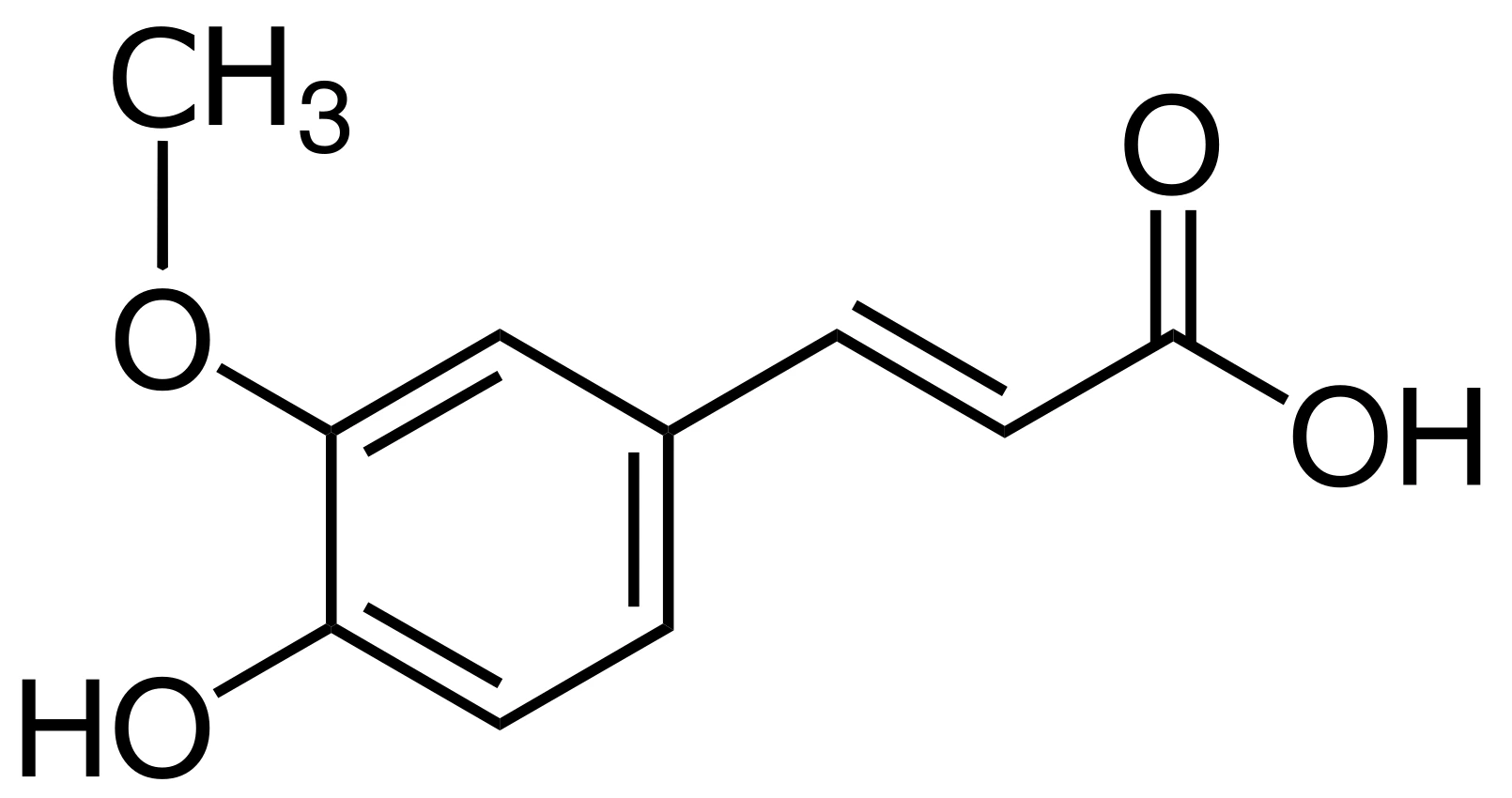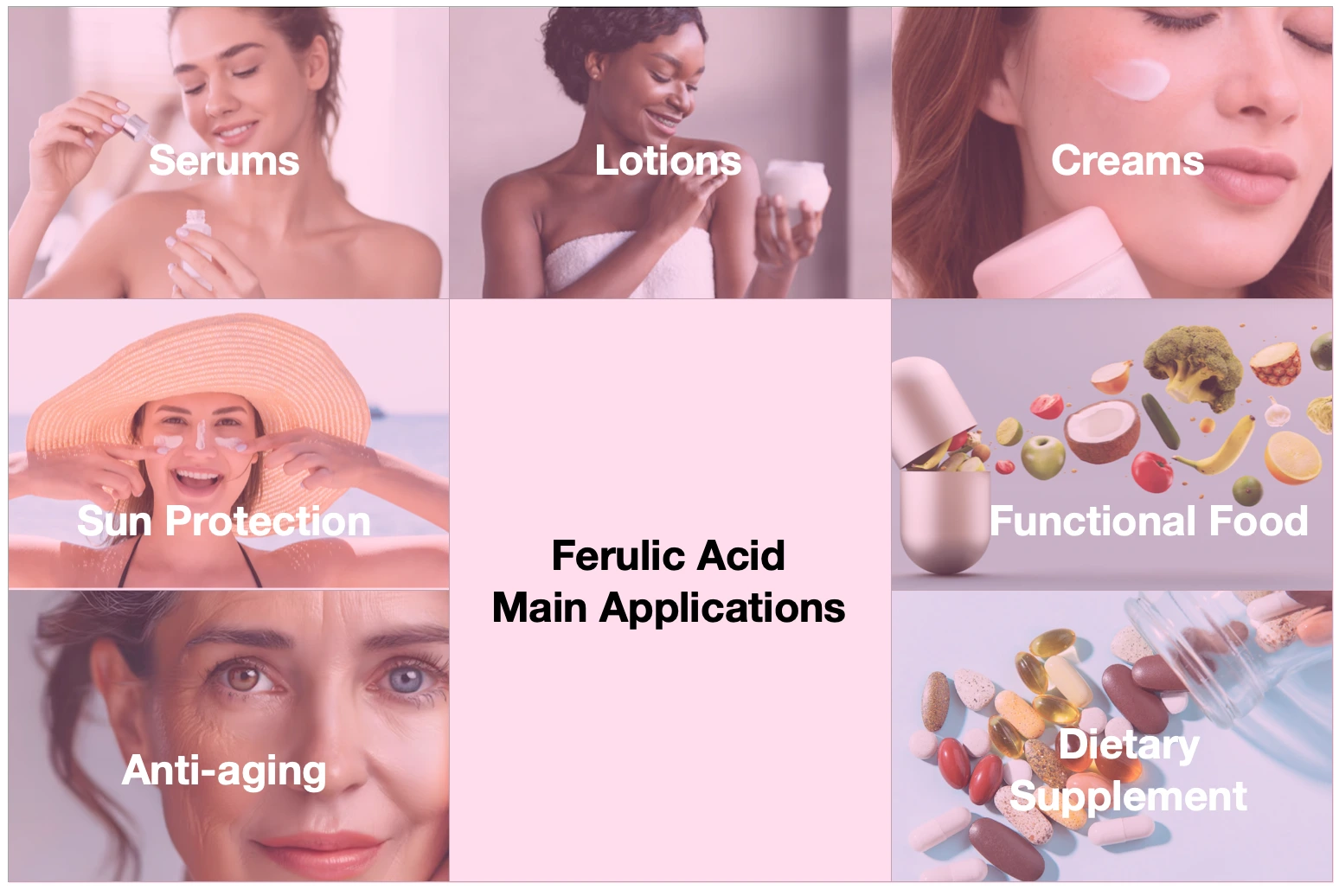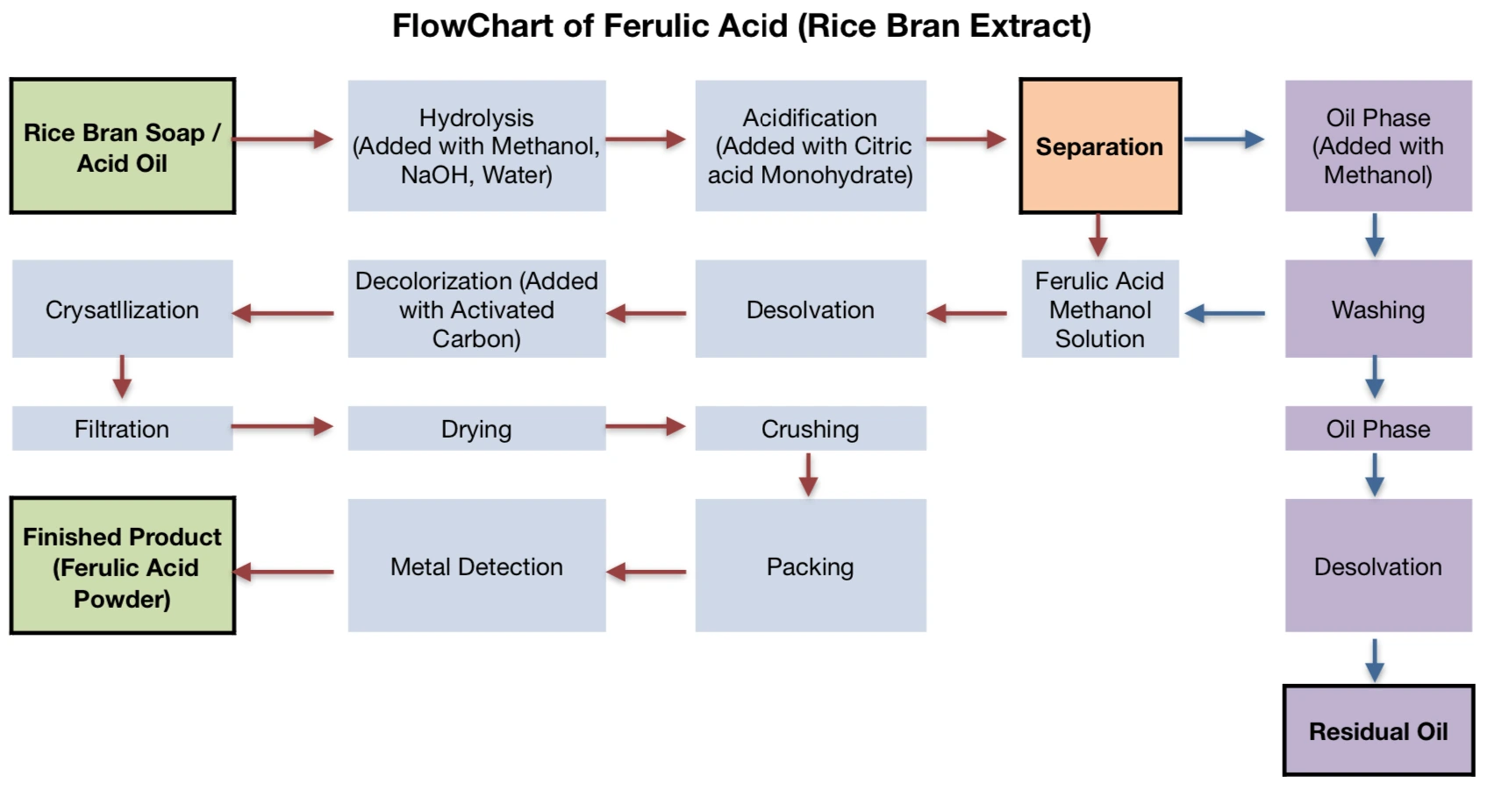Ferulic Acid ( Rice Bran Extract )
Ferulic Acid ( Rice Bran Extract )
Additional information
| Product Name | Ferulic Acid ( Rice Bran Extract ) |
|---|---|
| Appearance | Light yellow to white crystalline powder |
| Source | Natural Rice Bran Extract |
| Cas No. | 1135-24-6 |
| Solubility | Sparingly soluble in water, soluble in ethanol |
| Spec | Purity NLT 99% |
| Main Applications | Skincare, Sun Protection, Dietary Supplements, Pharmaceuticals, Food, etc. |
Product Details
Ferulic Acid: The Powerhouse Antioxidant from Rice Bran Extract

What is Ferulic Acid?
Ferulic Acid is a potent, plant-based antioxidant commonly found in the cell walls of rice bran, oats, wheat, and other grains.
Extracted from rice bran, it has gained immense popularity in the cosmetic, pharmaceutical, and food industries due to its exceptional antioxidant properties, which help combat oxidative stress, neutralize free radicals, and protect skin from environmental damage.
Ferulic Acid is 4-hydroxy-3-methoxycinnamic acid, which is one of the derivatives of cinnamic acid (also known as cinnamic acid, 3-phenyl 2 acrylic acid, molecular structure).
Ferulic acid can scavenge free radicals, promote the production of free radical scavenging enzymes, increase the activity of glutathione S-transferase and purine reductase, and inhibit tyrosinase activity to regulate human physiology.

Ferulic Acid is high-contained in Chinese herbal medicines such as Awei, Angelica, Chuanxiong, Cimicifuga, and Suanzaoren. It is one of the active ingredients of these traditional Chinese medicines and has been used as one of the quality indicators of proprietary Chinese medicines.

Among the food ingredients, the content of ferulic acid in coffee, chaff, vanilla bean, wheat bran and rice bran is also high. In recent years, studies on pharmacological effects have found that many ferulic acids and derivatives have pharmacological effects and biological activities, and their toxicity is low, so they have a wide range of uses in medicine, health care products, cosmetic raw materials and food additives.
CAS No and Chemical Structure
- CAS Number: 1135-24-6
- Chemical Structure: The molecular formula of ferulic acid is C₁₀H₁₀O₄, characterized by a phenolic acid structure with a double bond and carboxylic acid group.

Solubility
Ferulic Acid is sparingly soluble in water but is more soluble in ethanol and other organic solvents, such as ethanol, DMSO, and dimethyl formamide (DMF), The solubility of ferulic acid in these solvents is approximately 10, 15, and 20 mg/ml, respectively, making it versatile for incorporation into various formulations, especially in skincare and dietary supplements.
Benefits and Functions of Ferulic Acid
- Powerful Antioxidant: Ferulic acid neutralizes free radicals, reducing oxidative stress and protecting cells from environmental damage like UV rays and pollution.
- Anti-Aging Properties: It enhances the stability and effectiveness of other antioxidants, such as vitamins C and E, making it highly effective in reducing fine lines, wrinkles, and age spots.
- Skin Brightening: Ferulic acid inhibits melanin production, leading to a more even skin tone and reducing hyperpigmentation.
- Anti-Inflammatory: Its anti-inflammatory properties help soothe irritated skin, making it beneficial for sensitive skin formulations.
- Sun Protection: When combined with other ingredients, ferulic acid provides enhanced protection against UV-induced skin damage, making it a key component in sunscreens.
Specification of Ferulic Acid

- Appearance: Light yellow to white crystalline powder
- Purity: ≥99%
- Melting Point: 172-174°C
- Odor: Odorless
- Solubility: Sparingly soluble in water, soluble in ethanol
Main Applications

- Skincare Products: Ferulic acid is used in anti-aging serums, creams, and lotions to protect against oxidative stress and reduce the signs of aging.
- Sun Protection: It is included in sunscreens to enhance UV protection when combined with other antioxidants.
- Dietary Supplements: Ferulic acid is used in supplements for its antioxidant properties and health benefits, supporting overall well-being.
- Pharmaceuticals: Applied in topical treatments for skin conditions like eczema and psoriasis due to its anti-inflammatory and antioxidant properties.
- Food Industry: Acts as a natural preservative and is used in functional foods for its health-promoting benefits.
Production Flowchart
- Raw Material Extraction: Rice bran is the primary source of ferulic acid.
- Processing: The rice bran undergoes a series of extraction and purification processes to isolate ferulic acid.
- Filtration and Concentration: The extract is filtered, concentrated, and crystallized to obtain pure ferulic acid.
- Drying and Packaging: The purified ferulic acid is dried, powdered, and packed for distribution.

The flowchart outlines the extraction process of Ferulic Acid from Rice Bran. Here’s a simplified summary of the process:
- Raw Material (Rice Bran Soap/Acid Oil):
- Rice bran soap or acid oil is the starting material.
- Hydrolysis:
- The raw material undergoes hydrolysis, where methanol, NaOH, and water are added.
- Acidification:
- The hydrolyzed solution is acidified using citric acid monohydrate.
- Separation:
- After acidification, the process separates the oil phase and ferulic acid in a methanol solution.
- The oil phase undergoes additional washing and desolvation to obtain residual oil.
- Desolvation:
- The ferulic acid methanol solution is subjected to desolvation to remove the solvent.
- Decolorization:
- Activated carbon is added to decolorize the solution, removing impurities.
- Crystallization:
- The ferulic acid solution is crystallized.
- Filtration:
- The crystallized material is filtered.
- Drying & Crushing:
- The filtered product is dried and crushed.
- Metal Detection & Packing:
- After drying, the product undergoes metal detection to ensure safety, followed by packing.
- Finished Product:
- The final product is ferulic acid in powder form.
This method extracts ferulic acid, a valuable antioxidant, from rice bran, purifying it through a series of chemical treatments and mechanical processes.
How Does Ferulic Acid Work?
Ferulic acid works by neutralizing free radicals that can damage skin cells, reducing oxidative stress and preventing premature aging. It also stabilizes and boosts the effectiveness of other antioxidants, enhancing their protective abilities against environmental aggressors like UV rays and pollution.
Its anti-inflammatory properties soothe and protect the skin, making it a valuable addition to skincare and health products.
Dosage Guideline
- Skincare Products: Typically used at concentrations of 0.5% to 1% in serums and creams.
- Dietary Supplements: The recommended dosage varies but usually ranges from 250 mg to 500 mg per day.
- Sun Protection Products: 0.5% to 1% in combination with other antioxidants like vitamins C and E.
Why Choose Chibio Biotech?
Qingdao Chibio Biotech Co., Ltd. offers high-quality, rice bran-derived ferulic acid with several advantages:
- Purity and Quality: Our ferulic acid is extracted using advanced technology, ensuring high purity and effectiveness.
- Certifications: Chibio Biotech is certified with ISO22000:2018, Kosher, Halal, and FDA approvals, guaranteeing the safety and quality of our products.
- Experienced Manufacturer: With over 8+ years of experience, Chibio Biotech provides reliable, consistent products that meet global standards.
- Environmentally Friendly Extraction: We use sustainable and eco-friendly extraction methods, ensuring minimal environmental impact.
Why Use Ferulic Acid in Your Business?
- Versatile Applications: Suitable for skincare, dietary supplements, pharmaceuticals, and food products.
- Proven Efficacy: Ferulic acid offers powerful antioxidant, anti-aging, and protective benefits that enhance product performance.
- Consumer Demand: As consumers increasingly seek natural, plant-based ingredients, ferulic acid stands out as a must-have ingredient.
Incorporate Ferulic Acid Today! Enhance your product line with the powerful antioxidant benefits of ferulic acid.
Contact Chibio Biotech to source premium quality ferulic acid extracted from rice bran and elevate your products to meet the demands of today’s health-conscious consumers.
Get in touch with us to boost your business

- Get Free Sample
- Get Step Quote
- 24/7 Service
- Customized Specification
- Confidentiality Agreement
Headquarter
Block B, Vanke Center, No.2 Heilongjiang South Road, Shibei District, Qingdao City, China 266033
Phone
+86 (0)532 66983270
Cellphone / WhatsApp / WeChat
+86 156 6577 2296
+86 133 8100 5417




